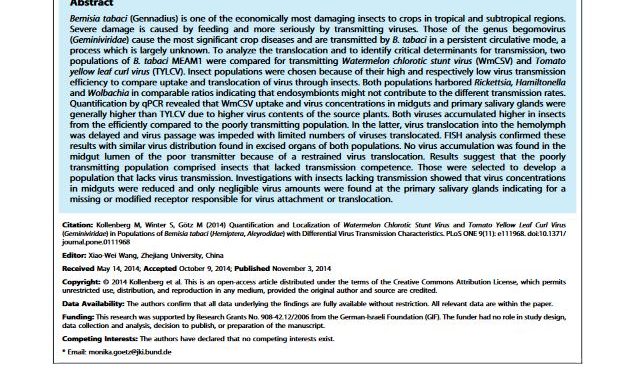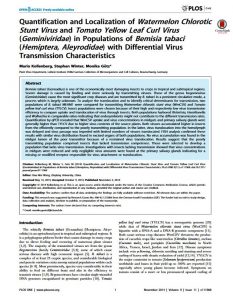Bemisia tabaci (Gennadius) is one of the economically most damaging insects to crops in tropical and subtropical regions. Severe damage is caused by feeding and more seriously by transmitting viruses. Those of the genus Begomovirus (Geminiviridae) cause the most significant crop diseases and are transmitted by B. tabaci in a persistent circulative mode, a process which is largely unknown. To analyse the translocation and to identify critical determinants for transmission, two populations of B. tabaci MEAM1 were compared for transmitting Watermelon chlorotic stunt virus (WmCSV) and Tomato yellow leaf curl virus (TYLCV). Insect populations were chosen because of their high and respectively low virus transmission efficiency to compare uptake and translocation of the virus through insects. Both populations harboured Rickettsia, Hamiltonella and Wolbachia in comparable ratios indicating that endosymbionts might not contribute to the different transmission rates. Quantification by qPCR revealed that WmCSV uptake and virus concentrations in midguts and primary salivary glands were generally higher than TYLCV due to higher virus contents of the source plants. Both viruses accumulated higher in insects from the efficiently compared to the poorly transmitting population. In the latter, virus translocation into the hemolymph was delayed and virus passage was impeded with limited numbers of viruses translocated. FISH analysis confirmed these results with similar virus distribution found in excised organs of both populations. No virus accumulation was found in the midgut lumen of the poor transmitter because of a restrained virus translocation. Results suggest that the poorly transmitting population comprised insects that lacked transmission competence. Those were selected to develop a population that lacks virus transmission. Investigations with insects lacking transmission showed that virus concentrations in midguts were reduced and only negligible virus amounts were found at the primary salivary glands indicating for a missing or modified receptor responsible for virus attachment or translocation.
Region: Not specific
Date published:
2014
Published by:
PLOS One
Type of resource:
Resource topic:
Tomato, Watermelon
Project/Programme: Not specific
Pest/Disease: Tomato viruses, Watermelon viruses
Pages:
12
File type:
External link (5.46 MB)




